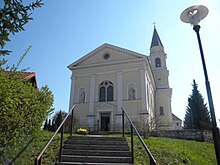Teharje
Teharje ( German cloths ) is a suburb and district of the Slovenian city of Celje (Cilli) and is located east of the city center on the Celje- Maribor railway line . It had 256 inhabitants at the 2002 census.
history
During the Second World War , the Wehrmacht set up a military camp for around 500 men with six living quarters and around ten functional barracks in 1943, which at times served as a training camp for the Hitler Youth . Towards the end of the war, the Germans locked prisoners there who were used in the defense of Cilli.
The camp was abandoned at the end of the war, but after the prisoners were extradited by the British in Bleiburg to Yugoslavia , it was used again as a prison camp by the victorious partisan army at the end of May 1945. On May 31, 1945, the “Rupnik Battalion” was brought in (previously led by Vuk Rupnik , Leon Rupnik's son ) and, in the following days in June, another 3,000 or so members of the Slovenian Home Guard . In addition to Domobranzen and civilians seen as opponents, Germans from Lower Styria and Gottschee were also held here.
In 2008 the Slovenian EU Council Presidency held a hearing on “crimes of totalitarian regimes”, during which Teharje was also discussed in more detail. Some of the internees in the Teharje camp were subsequently executed in the immediate vicinity, but most were killed in the vicinity of Stari Hrastnik , Trbovlje and Laško , many of them in abandoned mines . Of the several thousand camp inmates in Teharje in May and June 1945, only a small number of civilians and around 400 underage members of the Slovenian Home Guard survived. These were released after an amnesty on August 3, 1945, but some were killed on the way home. A former partisan testified in 1994 that in June 1945 he had brought domobranzen captured from the Teharje camp to the Barbara tunnel in the Huda Jama mine near Laško for execution . As with the prisoners, the partisans guards were also Slovenes. Within five days, four trucks drove two to three times a day until the mine was full. The number of victims who were killed in Teharje immediately after the end of World War II without a trial is estimated at 5,000.
In 1946 Teharje served as a labor camp and was closed in October 1946.
After Slovenia's independence, a memorial park (spominski park Teharje) and a memorial were built by the state on the site of the former camp based on designs by architect Marko Mušič and opened on October 10, 2004 by the President of the Parliament, Feri Horvat . The park, which cost around 500 million tolar to build , is dedicated to the "secret victims of the post-war massacres".
literature
- Matjaž Klepec: Cloths are soaked in our blood: The fate of the home guardians (Domobranci) . Self-published, Buenos Aires 1973 (translation from Slovenian, Bleiburg, 1996).
- Ivan Korošec (1994): Teharje - krvave arene. Ilex-Impex, Ljubljana. (Personal reports.) ISBN 9616118021
- Roman Leljak (1990): Teharske žive rane. Cankarjeva založba, Ljubljana.
- Janez Zdešar (2005): Spomini na težke dni. Beg iz teharskega taborišča [memories of difficult days. Escape from the Tüchern camp (Slovenian)], Založba Družina. ISBN 961-222-568-0
- Milko Mikola (2008): Dokumenti in pričevanja o povojnih koncentracijskih taboriščih v Sloveniji: Del 2, Koncentracijska taborišča Št. Vid nad Ljubljano, Škofja Loka in Teharje ter taborišče za otroke Petriček. Ljubljana, Študijski center za narodno spravo, 2008.
Web links
- Na Teharjah spominska slovesnost za žrtve medvojnega in povojnega nasilja. Dnevnik, October 5, 2008 (Slovenian)
- Spomin na teharske poboje. 24ur.com, June 12, 2005 (Slovenian)
Individual evidence
- ↑ Enciklopedija Slovenije, Volume 13, entry "Teharje"
- ↑ Among them Viktor Michitsch as a child, today's chairman of the Gottscheer Landsmannschaft in Klagenfurt, who managed to escape to Austria with his family. See Gottscheer Zeitung, June 2004, page 5 ( memento of the original from March 25, 2007 in the Internet Archive ) Info: The archive link was inserted automatically and has not yet been checked. Please check the original and archive link according to the instructions and then remove this notice. (PDF; 2.2 MB).
- ↑ Milko Mikola: Concentration and labor camps in Slovenia, in: Slovenian Presidency of the Council of the European Union, Peter Jambrek (ed.): Crimes committed by totalitarian regimes (pp. 145–154) ( Memento from October 4, 2011 in Internet Archive ) (PDF; 4.6 MB), p. 148. Reports and proceedings of the 8 April European public hearing on “Crimes committed by totalitarian regimes”, organized by the Slovenian Presidency of the Council of the European Union (January– June 2008) and the European Commission
- ↑ Damjan Hančič and Renato Podberšič: Totalitarian regimes in Slovenia in the 20th century, in: Slovenian Presidency of the Council of the European Union, Peter Jambrek (ed.): Crimes committed by totalitarian regimes (pp. 39-60) ( Memento from October 4, 2011 in the Internet Archive ) (PDF; 4.6 MB), p. 53. Reports and proceedings of the April 8 European public hearing on “Crimes committed by totalitarian regimes”, organized by the Slovenian Presidency of the Council of the European Union (January – June 2008) and the European Commission
- ↑ Testimony of the former partisan Jakob Ugovšek before the investigative commission in 1994 (PDF; 69 kB)
- ↑ Slovenec, May 10, 1994, page 4. (PDF; 381 kB)


